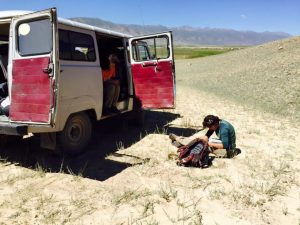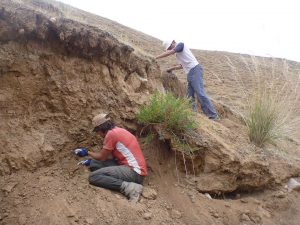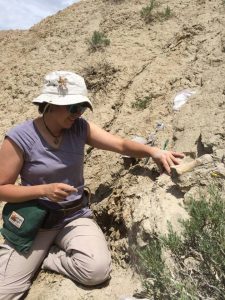October 12, 2016
Fossils and a Soviet ambulance in Kyrgyzstan? That and more – Our Q & A with Paleontologist Win McLaughlin on National Fossil Day
Posted by smaguffin
As part of Earth Science Week, we’ll be highlighting different leaders in the geosciences – from research to education and community outreach. We are posting Q&A’s on The Bridge asking geoscientists about the work they do.
Today’s theme is National Fossil Day and one of our featured AGU members is Win McLaughlin. Win is a PhD Candidate at the University of Oregon. In 2015, Win was awarded a Fulbright Scholarship to help further her research in Kyrgyzstan. She spent 10 months in and around Bishkek doing fieldwork. You can read about her experience on her blog.

Win, next to her Soviet era converted ambulance, excavating a horse tooth fossil in Ortok, Kyrgyzstan.
Can you summarize your research in a sentence or two?
I use vertebrate mammalian fossil assemblages to better constrain the geochronology of both climatic and tectonic evolution. My main areas of fieldwork (Kyrgyzstan and Central Oregon) are similar in that the middle to late Cenozoic highlights periods of rapid mammalian evolution occurring in conjuncture with tectonic and climatic change.
What is a common misconception people have about fossils/paleontology?
So many things! I think one of the biggest is that you need complete skeletons of an organism to understand anything about the organism’s biology and ecology. The morphology (physical shape) of even tiny scraps of bones and teeth can hugely illuminate how an ancient animal moved, what it ate, and how it interacted with the landscape around it. Beyond morphology, the chemical makeup of bone and teeth can record a snapshot of ancient climate as well as an organism’s place within a food web.
Why is studying paleontology important for science and society today?
While climate scientists overwhelming agree climate change is occurring now, the continued rate and extent of change, much less the biotic response to that change is debated. The fossil record provides repeated examples of how organisms respond to climatic change, how ecosystems are restructured, and what types or degrees of climatic change drive extinction events. My fieldwork in Central Oregon centers around the Mid-Miocene Thermal Optimum, which is the warmest the earth has been in the latter half of the Age of Mammals. Much of this heating occurred geologically quickly, thus it provides one example of how life responded to a warming event. My work in Kyrgyzstan is from even younger rocks (about 7 million years old) with animals much more similar to those we still see alive today. This time period does not represent a time of global climate change, but does occupy a very important snapshot of changing local climates on a quick scale. As the Pamirs and Tien Shan mountains were uplifted, they eventually prevented the Indian monsoons from reaching Central Asia. Without the yearly monsoon, the types of organisms occupying the region quickly shifted, offering another fossil record case study of just how quickly biota can respond to climate change and which types of organisms are more impacted.
How do you see the role of science and earth science in society?
Science literacy in the general framework of society is crucial. We as citizens are constantly presented with the results of science, be it in the technology we use in daily lives, to medical decisions, or even economics. Without a certain level of literacy, much of the data presented is ignored or misinterpreted. This is particularly relevant in earth sciences, as earth sciences encompass much of the breadth of our interactions with our landscape. Where our water and food comes from, but also the availability of elements and minerals crucial to fabricating the tools of civilization (from basic home materials to technological equipment). The role of earth science in our continued development of society is not just to provide the raw materials for expansion, but also foster an understanding of our interactions with the landscape we inhabit.
How, if at all, is your working supported/affected by federal/state funding?
Just looking at the last few years I have been hugely impacted by federal funding. Most importantly I received a 2015 Fulbright student research grant from the US State Department to cover my research in Kyrgyzstan. I was able to spend 10 months living and conducting research in Kyrgyzstan and also worked with the US embassy to promote STEM involvement with Kyrgyz primary and secondary school youth. The majority of my field-based research was made possible solely because of this grant.
Do you have a favorite photograph from your career? If so, would you share it with us and tell us why it is important to you?
I picked three photos if any of them work: The first photo is from one of my sites near Ortok Kyrgyzstan. Most of the time I have to prospect for hours to find new fossil-bearing strata and then spend additional hours on excavation… other times you step out of your Soviet era converted ambulance and find a fossil horse tooth lying on the ground by where you parked… The second photo I really like both because it’s one of my favorite fossils localities where I excavated a complete fossil rhino skeleton, but also because it highlights working with Kyrgyz geology students! Azatbek found several ankle bones higher up the slope from where I’m excavating a jaw of a rhino. The third picture is near Kochkor Kyrgyzstan where I am excavating a fossil elephant pelvis from a hillside. What the photo doesn’t show is that the base of the valley is over 100 m below me!
Are there any social media or website links you would like us to promote?
I frequently tweet about fossils resources, fossil preparation, fossil curation, and science education as well as #FossilFriday! I’m @paleowin on Twitter.



